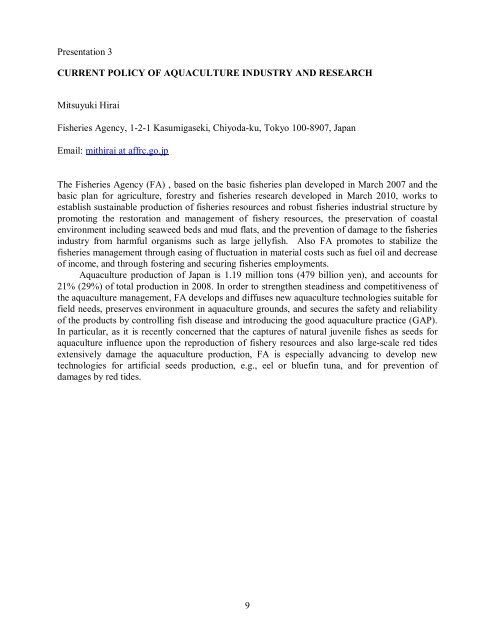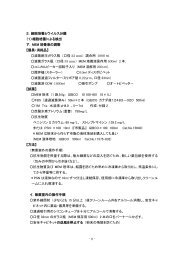Program and Abstracts(PDF)
Program and Abstracts(PDF)
Program and Abstracts(PDF)
You also want an ePaper? Increase the reach of your titles
YUMPU automatically turns print PDFs into web optimized ePapers that Google loves.
Presentation 3<br />
CURRENT POLICY OF AQUACULTURE INDUSTRY AND RESEARCH<br />
Mitsuyuki Hirai<br />
Fisheries Agency, 1-2-1 Kasumigaseki, Chiyoda-ku, Tokyo 100-8907, Japan<br />
Email: mithirai at affrc.go.jp<br />
The Fisheries Agency (FA) , based on the basic fisheries plan developed in March 2007 <strong>and</strong> the<br />
basic plan for agriculture, forestry <strong>and</strong> fisheries research developed in March 2010, works to<br />
establish sustainable production of fisheries resources <strong>and</strong> robust fisheries industrial structure by<br />
promoting the restoration <strong>and</strong> management of fishery resources, the preservation of coastal<br />
environment including seaweed beds <strong>and</strong> mud flats, <strong>and</strong> the prevention of damage to the fisheries<br />
industry from harmful organisms such as large jellyfish. Also FA promotes to stabilize the<br />
fisheries management through easing of fluctuation in material costs such as fuel oil <strong>and</strong> decrease<br />
of income, <strong>and</strong> through fostering <strong>and</strong> securing fisheries employments.<br />
Aquaculture production of Japan is 1.19 million tons (479 billion yen), <strong>and</strong> accounts for<br />
21% (29%) of total production in 2008. In order to strengthen steadiness <strong>and</strong> competitiveness of<br />
the aquaculture management, FA develops <strong>and</strong> diffuses new aquaculture technologies suitable for<br />
field needs, preserves environment in aquaculture grounds, <strong>and</strong> secures the safety <strong>and</strong> reliability<br />
of the products by controlling fish disease <strong>and</strong> introducing the good aquaculture practice (GAP).<br />
In particular, as it is recently concerned that the captures of natural juvenile fishes as seeds for<br />
aquaculture influence upon the reproduction of fishery resources <strong>and</strong> also large-scale red tides<br />
extensively damage the aquaculture production, FA is especially advancing to develop new<br />
technologies for artificial seeds production, e.g., eel or bluefin tuna, <strong>and</strong> for prevention of<br />
damages by red tides.<br />
9



